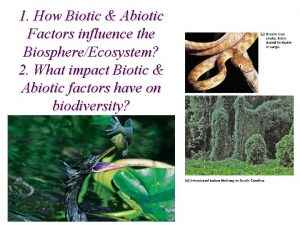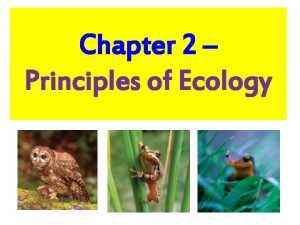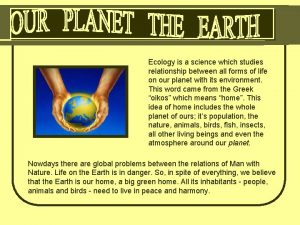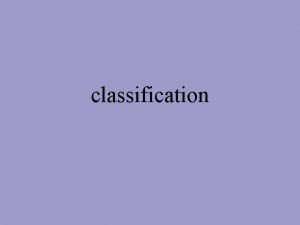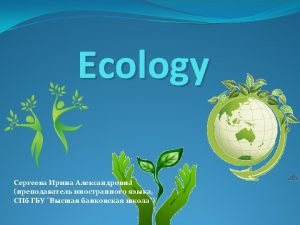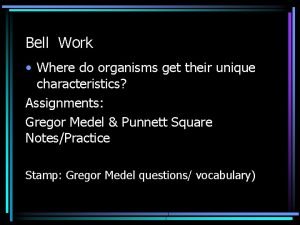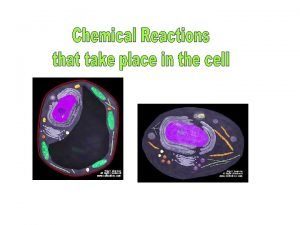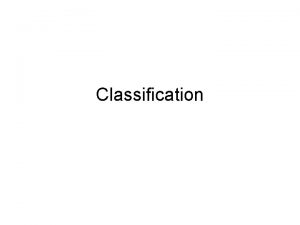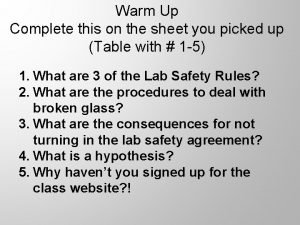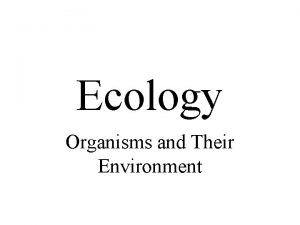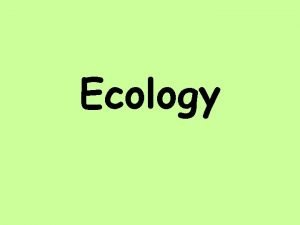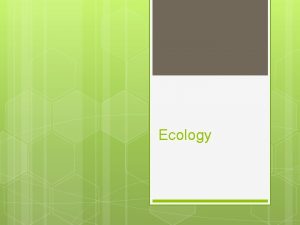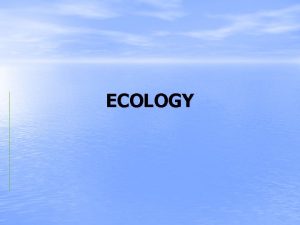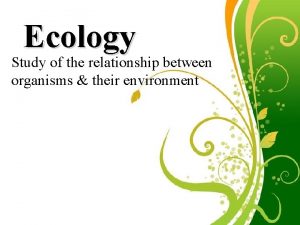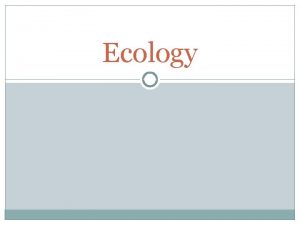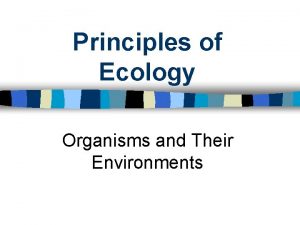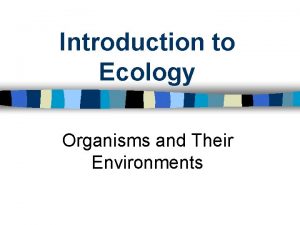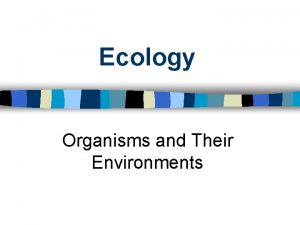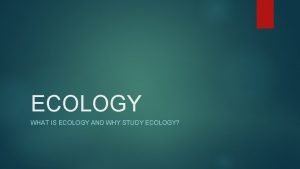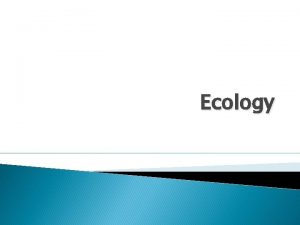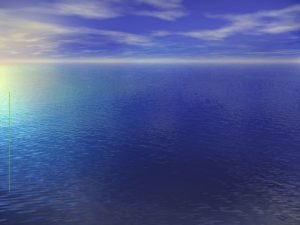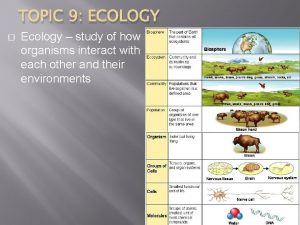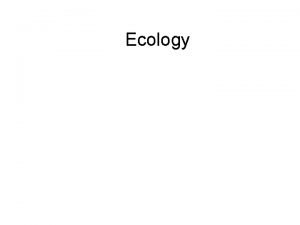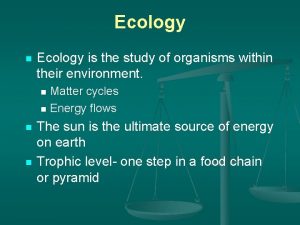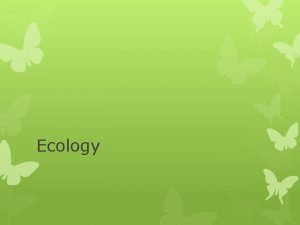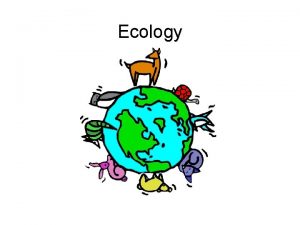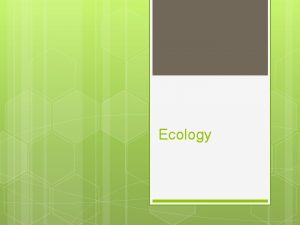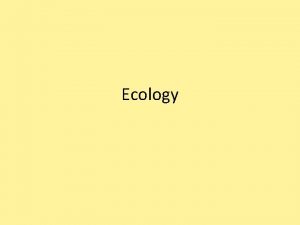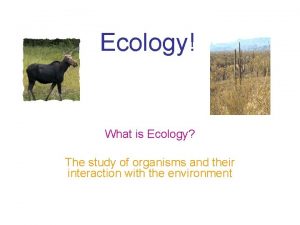Ecology the study of organisms and their relationship

























































- Slides: 57

Ecology

• the study of organisms and their relationship to the environment and each other

Ecosystem Components • Biotic Components (living factors) • Plants • Decomposers (Bacteria, Fungi) • Animals • Abiotic Components (nonliving factors) • Water • Atmosphere (temperature, p. H, O 2, CO 2) • Soil

Basic Terms

Population • A POPULATION is all of the individuals of a single species that live within a certain area

Community • A community is all of the populations of different organisms within a given area

Ecosystem • The ecosystem is the collection of all the organisms that live in a particular place together with the abiotic limiting factors


Biome • A BIOME is a group of ecosystems that have the same climate and are characterized by specific plants and animals

Biosphere • portions of the planet where life can exist (land, water, lower atmosphere)

Energy Flow Relationships • What is the source of energy for all living things?

• The sun is the source of energy for all photosynthetic autotrophs

• Some autotrophs are chemosynthetic • They can use chemicals like sulfer to obtain the energy to make organic molecules • Ex) bacteria near deep sea volcanic vents

Food chains show the flow of energy from the sun through producers and consumers in an ecosystem

• Producers an autotroph that synthesizes new organic molecules by photosynthesis or chemosynthesis – Autotrophs are ALWAYS the bottom of a food chain

• Consumers organisms that eat plants and/or other animals – Primary consumer eats plants – Secondary consumer eats primary consumer – Tertiary consumer eats the secondary consumer

Herbivores • Consumers that eat the producers (autotrophs)

carnivores • Consumers that eat other consumers – Predator – kills its food – Scavenger – eats dead animals

Omnivore • Consumers that eat BOTH autotrophs and other consumers

Decomposers • Bacteria, some worms and fungi that break down dead organic material and return the nutrients to the soil

Important Concepts • Energy flow through an ecosystem is shown with arrows in a food chain or food web.


• Nutritional relationships are never as simple as a food chain • A FOOD WEB is a diagram that shows overlapping food chains – Organisms eat more than one thing – Organisms are eaten by more than one thing



• Most energy is stored in the producers and the producers should be the most abundant organism in any food chain or food web.

• An ecosystem is self-sustaining if: a) there is a constant source of energy (sun, chemicals) b) there is a continuous cycle of materials (decomposers recycle organic material back into the environment)

Food pyramid relationships Diagrams showing how certain factors change within a food chain

Pyramid of energy • Measures the potential energy in the molecules of organisms at each level of the pyramid • The 10% rule – only 10% of energy passes from one step to the next • Organisms are using the energy for their own life functions (metabolism)

Pyramid of biomass • Measures the quantity or organic material present at one time in an environment • In which level is MOST of the organic material found in an environment? • WHY?

Pyramid of numbers • Measures the total number of organisms that occupy each level • The largest number of organisms are the producers • WHY are there fewer tertiary consumers than secondary consumers?

Biological magnification • The accumulation of toxic substances in higher levels of a food chain • These are mainly substances that are not easily excreted by animals – Example) the herbicide DDT


Nutrient recycling • Different organisms chemically transform molecules containing important elements which makes them available to other organisms

The water cycle

The carbon cycle

The nitrogen cycle

• Plant and animal wastes decompose, adding nitrogen to the soil in the form of NH 4. – This is called ammonification • .

• Bacteria in the soil convert these forms of nitrogen into forms plants can use. • Plants absorb the nitrates in the soil to use for protein and nucleic acid synthesis. – This is called assimilation

• People and animals eat the plants; then animal and plant residues return nitrogen to the soil again, completing the cycle.

Soil bacteria that assist in the nitrogen cycle include • Nitrifying bacteria convert ammonia to nitrate (NO 3 -1) which is a form of nitrogen the plants can use

• Nitrogen fixing bacteria convert atmospheric nitrogen gas (N 2) to nitrates

• Denitrifying bacteria convert excess nitrates in soil to N 2 gas which enters the atmosphere


Ecological succession • As organisms live in a given area their activities can alter the environment • The altered environment may be better suited to a newer, more complex, group of organisms

Primary succession • The environment begins as a bare rock surface • The first organisms are the pioneer organisms

• Most often the pioneer organism is Lichens – Lichens are algae and fungus living in a mutualistic symbiotic relationship

• Metabolic wastes produced by the lichens help break the rock into smaller pieces • Dead lichens decompose and the molecules mix with pieces of rock to form soil

• Tiny plants like mosses grow and replace the lichens • Mosses help to create better soil

• Larger plants can survive once the soil is suitable • Lichens mosses grasses shrubs trees

• As larger plants grow, a wider variety of animals can survive in the area

Climax community • A mature, stable community that is difficult to change

Secondary succession • This type of succession occurs in areas in which the climax community has been destroyed by a catastrophe – Ex) Fire, flood, earthquake, landslide

• This area will end in the same climax community because: • The area has existing soil • The climate of the community has not changed

Pond succession • Lakes and ponds also pass through stages of ecological succession • This begins when sediment, fallen leaves and other debris gradually accumulate on the lake bottom


• As the lake fills in it becomes rich in nutrients that can support a large population of organisms
 Principles of ecology section 3 cycling of matter
Principles of ecology section 3 cycling of matter Principles of ecology section 3 cycling of matter
Principles of ecology section 3 cycling of matter Organism
Organism Levels of organization in the biosphere
Levels of organization in the biosphere Competitive interaction
Competitive interaction Section 1 organisms and their relationships
Section 1 organisms and their relationships Chapter 2 section 1 organisms and their relationships
Chapter 2 section 1 organisms and their relationships Chapter 2 principles of ecology answer key
Chapter 2 principles of ecology answer key Living organisms and their surroundings
Living organisms and their surroundings Chapter 2 section 1 organisms and their relationships
Chapter 2 section 1 organisms and their relationships Ecology is a science which studies the relationship between
Ecology is a science which studies the relationship between Human order taxonomy
Human order taxonomy Crayfish taxonomy
Crayfish taxonomy Biology ecology study guide answer key
Biology ecology study guide answer key Study guide chapter 3 section 1 community ecology
Study guide chapter 3 section 1 community ecology Ecology is the study that helps to preserve
Ecology is the study that helps to preserve Where do organisms get their traits?
Where do organisms get their traits? Where do all organisms get their energy
Where do all organisms get their energy Method of grouping organisms based on their similarities
Method of grouping organisms based on their similarities Organisms that make their own food
Organisms that make their own food Difference between rm and crm
Difference between rm and crm What does two households both alike in dignity
What does two households both alike in dignity Hình ảnh bộ gõ cơ thể búng tay
Hình ảnh bộ gõ cơ thể búng tay Bổ thể
Bổ thể Tỉ lệ cơ thể trẻ em
Tỉ lệ cơ thể trẻ em Chó sói
Chó sói Tư thế worms-breton
Tư thế worms-breton Hát lên người ơi alleluia
Hát lên người ơi alleluia Các môn thể thao bắt đầu bằng tiếng bóng
Các môn thể thao bắt đầu bằng tiếng bóng Thế nào là hệ số cao nhất
Thế nào là hệ số cao nhất Các châu lục và đại dương trên thế giới
Các châu lục và đại dương trên thế giới Công thức tính thế năng
Công thức tính thế năng Trời xanh đây là của chúng ta thể thơ
Trời xanh đây là của chúng ta thể thơ Cách giải mật thư tọa độ
Cách giải mật thư tọa độ 101012 bằng
101012 bằng độ dài liên kết
độ dài liên kết Các châu lục và đại dương trên thế giới
Các châu lục và đại dương trên thế giới Thơ thất ngôn tứ tuyệt đường luật
Thơ thất ngôn tứ tuyệt đường luật Quá trình desamine hóa có thể tạo ra
Quá trình desamine hóa có thể tạo ra Một số thể thơ truyền thống
Một số thể thơ truyền thống Cái miệng bé xinh thế chỉ nói điều hay thôi
Cái miệng bé xinh thế chỉ nói điều hay thôi Vẽ hình chiếu vuông góc của vật thể sau
Vẽ hình chiếu vuông góc của vật thể sau Nguyên nhân của sự mỏi cơ sinh 8
Nguyên nhân của sự mỏi cơ sinh 8 đặc điểm cơ thể của người tối cổ
đặc điểm cơ thể của người tối cổ Ví dụ về giọng cùng tên
Ví dụ về giọng cùng tên Vẽ hình chiếu đứng bằng cạnh của vật thể
Vẽ hình chiếu đứng bằng cạnh của vật thể Phối cảnh
Phối cảnh Thẻ vin
Thẻ vin đại từ thay thế
đại từ thay thế điện thế nghỉ
điện thế nghỉ Tư thế ngồi viết
Tư thế ngồi viết Diễn thế sinh thái là
Diễn thế sinh thái là Dạng đột biến một nhiễm là
Dạng đột biến một nhiễm là Số nguyên là gì
Số nguyên là gì Tư thế ngồi viết
Tư thế ngồi viết Lời thề hippocrates
Lời thề hippocrates Thiếu nhi thế giới liên hoan
Thiếu nhi thế giới liên hoan








